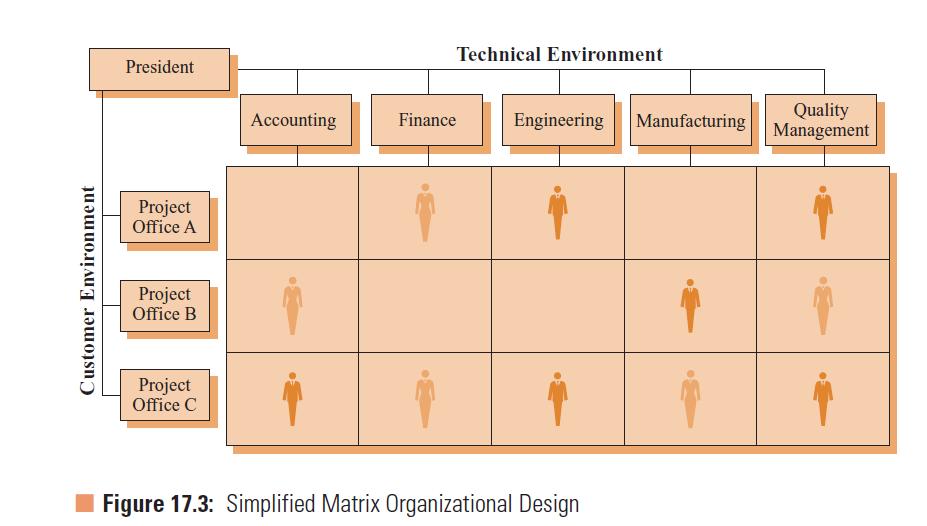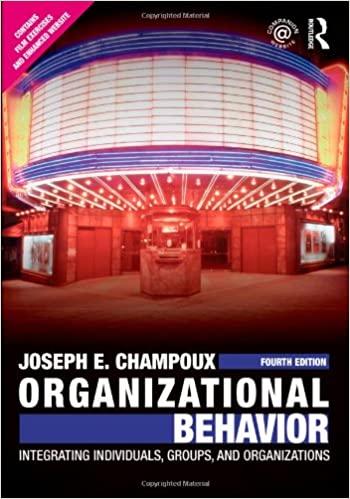Discuss the characteristics of matrix organizations. What environmental conditions contribute to choosing this complex organizational design? What
Question:
Discuss the characteristics of matrix organizations. What environmental conditions contribute to choosing this complex organizational design? What skills do people need to successfully work in and manage a matrix organization?
Matrix Organizational Design
Organizations often use a matrix design when two sectors of the external environment demand management attention. For example, if the organization produces products using advanced technology and its customers have highly specialized needs, both changes in technology and changes in customer needs require management’s attention. Organizations also often move to a matrix form after other organizations in their region or industry have adopted it. The word matrix evolved during the 1950s within the U.S. aerospace industry to describe the grid-like organizational design used in project management. This design rejects the long-standing recommendation of unity of command with each employee getting direction from only one boss. Matrix organizational designs have multiple authority structures, so that many people report to two managers. Figure 17.3 shows a simple matrix organizational design. People from different functional areas of the company (the top row) are assigned to various projects (the left column). Each person assigned to a project reports to at least two supervisors or managers. One supervisor is in the functional area and the other is in a project.
The mixture of people from the functional areas varies according to project needs. Some projects, such as Project Office C, need people from all functional areas. Other projects, such as Project Offices A and B, need people only from some functional areas. After a person finishes a project, he returns to the functional area.
Multiple reporting relationships are a basic feature of matrix organizations, distinguishing them from the forms discussed earlier. Although reporting to two or more managers might appear odd, many people have experienced this relationship as children when both their mother and father have authority. Children often skillfully navigate these multiple authority relations.
The following are the conditions under which an organization might choose a matrix design:
Pressures from the external environment for a dual focus. The example from the aerospace industry described fast changes in technology and customer needs. Those pressures moved managers to adopt the matrix form’s multiple focus.
High uncertainty within multiple external environment sectors. Multiple elements in the external environment are changing fast, creating high uncertainty about future environmental states. High uncertainty creates a strong need for more information.
Constraints on human and physical resources. Most organizations have constraints on expanding their human or physical resources. This is especially true when the resources are expensive specialists or costly technical equipment. The matrix organizational form encourages sharing those resources and allows the flexibility to meet competing requests.
Managers can design a matrix organization in different ways. Some organizations use a matrix form within specific functional areas only. Such an arrangement is common in a marketing department. Managers responsible for a brand or group of brands bring all the marketing skills together to focus on the products. Other organizations use temporary matrix forms to complete specific projects, with the matrix organization disbanding after project completion. Still other organizations have the matrix form as a permanent feature of their organizational design.
Matrix organizations place high demands on managers’ skills. Because of a matrix organization’s high conflict potential, managers need well-developed conflict management skills. When managers have poor conflict management skills, matrix organizations become seriously dysfunctional. (See Chapter 11, “Conflict in Organizations,” for a complete discussion of conflict and conflict management.)
Matrix organizations demand coordination, cooperation, and communication. The communication often is face to face and in groups or teams. Both managers and nonmanagers must have high levels of interpersonal skill to function successfully in matrix organizations. Individuals who do not like high levels of human contact will find matrix organizations uncomfortable.
The strengths of matrix organizations include responsiveness, flexibility, efficient use of costly resources, and potentially high levels of human motivation and involvement. The dual focus of matrix organizations lets management respond quickly to changes in market or product demand. Matrix organizations share scarce and often expensive human and physical resources among different projects. Individuals in a matrix organization can get information about a total project, not only about their particular specialty.
A matrix organization’s weaknesses include the ambiguity caused by dual or multiple authority relationships for many people. Ambiguity in authority relationships can encourage power struggles among managers who compete for dominance. People reporting to both a functional and a project manager can experience opposing demands from the two managers. Matrix organizations are also complex systems with high conflict potential. Such conflict can reach dysfunctionally high levels. These weaknesses can cause significant stress for people in such organizations.
Step by Step Answer:

Organizational Behavior Integrating Individuals Groups And Organizations
ISBN: 9780415804646
4th Edition
Authors: Joseph E. Champoux





